UH 60 Black Hawk: From Idea to Modern Day Applications
UH 60 Black Hawk: From Idea to Modern Day Applications
Blog Article
Checking Out the Cutting-edge Modern Technology Behind Aircraft Design and Engineering
The field of airplane style and engineering is witnessing a transformative change driven by innovative modern technologies that improve efficiency, sustainability, and effectiveness. As the industry grapples with the challenges of environmental responsibility, advancements in lasting aeronautics technologies promise to improve the future.
Advanced Materials in Airplane Style
How can the combination of innovative products transform airplane layout? The consolidation of advanced materials, such as carbon fiber composites, titanium alloys, and progressed porcelains, plays a critical role in enhancing aircraft efficiency and effectiveness. These materials offer remarkable strength-to-weight proportions, making it possible for manufacturers to minimize total aircraft weight without endangering structural honesty. This reduction in weight directly adds to boosted gas efficiency and increased haul capability.
Additionally, advanced products exhibit enhanced resistance to deterioration and tiredness, leading to reduced upkeep prices and prolonged life span. The usage of titanium in vital elements assists hold up against severe temperatures and anxieties, while carbon fiber composites give adaptability in design and production procedures. This adaptability enables even more aerodynamic forms, adding to superior efficiency attributes.
Moreover, the assimilation of wise materials, which can alter residential or commercial properties in response to exterior stimuli, opens brand-new avenues for flexible systems in aircraft layout. uh 60. These advancements assure not just to boost security and operational efficiency yet additionally to add to sustainability initiatives by decreasing ecological influence through minimized emissions. In summary, progressed materials are redefining the landscape of aircraft layout, paving the means for much more efficient, durable, and ecologically pleasant aviation services
Aerodynamic Advancements for Performance
Wind resistant advancements play a pivotal role in enhancing airplane efficiency, considerably influencing gas consumption and total performance. Developments in airfoil layout, such as the intro of supercritical wings, enable optimized lift-to-drag ratios, decreasing drag at transonic rates. These innovations enable aircraft to maintain greater rates with reduced fuel expense, straight affecting functional prices and environmental sustainability.
Moreover, the assimilation of winglets has actually verified effective in alleviating vortex-induced drag at the pointers of wings, additionally improving fuel performance - uh 60. This style adjustment causes a decrease in wake turbulence, adding to improved wind resistant performance throughout cruise ship conditions

Moreover, computational fluid dynamics (CFD) tools have actually revolutionized the screening and refinement of wind resistant forms, permitting specific simulations of air flow around aircraft (uh 60). This allows engineers to introduce constantly, guaranteeing that modern aircraft not just satisfy regulative standards but also push the boundaries of effectiveness in aeronautics

Duty of Computer Simulations
Computer system simulations have actually become an indispensable device in the field of aircraft layout, allowing designers to conduct thorough evaluations and optimizations of various layout aspects. These simulations permit the virtual screening of wind resistant homes, architectural honesty, and efficiency metrics long prior to physical models are constructed. By employing computational liquid characteristics this (CFD) and finite component analysis (FEA), engineers can forecast exactly how air streams around the airplane and exactly how various materials will certainly reply to stress and anxiety and stress.
Moreover, computer system simulations facilitate the exploration of a vast array of variables and circumstances, increasing the design process and decreasing costs linked with physical testing. This capability not only boosts the precision of predictions relating to airplane behavior but additionally supplies understandings right into prospective design enhancements that may not be right away noticeable with typical methods.

Furthermore, simulations assist make sure compliance with stringent security guidelines by permitting designers to identify and fix possible concerns early in the layout stage. The assimilation of simulation technologies right into the airplane design process emphasizes the substantial innovations in design practices, inevitably adding to the growth of much safer, much more efficient, and eco-friendly airplane.
Artificial Knowledge in Design
Expert system (AI) is revolutionizing the design landscape, particularly in aircraft style, by optimizing and boosting decision-making processes layout workflows. Through artificial intelligence algorithms, AI can examine large datasets, revealing patterns and insights that notify style choices and enhance overall performance.
AI applications in airplane style include generative layout, where algorithms develop several design choices based on specified criteria, allowing engineers to examine a more comprehensive variety of opportunities. This not only accelerates the design stage but also makes certain that the last items meet stringent performance and safety requirements.
Additionally, AI-driven anticipating analytics promote maintenance scheduling by analyzing historic data and anticipating possible failings. This proactive technique lowers downtime and improves aircraft reliability.
Additionally, AI help in simulation and modeling, enabling designers to check layouts under numerous conditions without the need for physical prototypes. This ability reduces development timelines and lessens prices associated with traditional testing techniques.
Lasting Aeronautics Technologies
The solution lies in the adoption of lasting aeronautics modern technologies that my latest blog post focus on efficiency and reduce carbon discharges. Innovations such as sustainable air travel gas (SAFs), which are acquired from eco-friendly sources, have arised as an essential component in accomplishing lower lifecycle discharges.
Furthermore, innovations in airplane layout, such as the advancement of lighter materials and more aerodynamically reliable shapes, add to boosted gas effectiveness. Electric and hybrid propulsion systems are likewise gaining traction, providing a path to minimize dependence on fossil fuels and lessen greenhouse gas discharges.
The integration of these innovations is sustained by governing frameworks and market collaborations targeted at establishing enthusiastic sustainability targets. Electronic tools like information analytics and synthetic intelligence can enhance trip procedures, better improving fuel efficiency. By accepting lasting techniques and technologies, the air travel sector can not only satisfy the expanding need for flight but likewise play a critical duty in addressing climate modification, making sure a much more lasting future for air transport.
Final Thought
The this link convergence of advanced materials, wind resistant developments, and innovative modern technologies marks a significant advancement in aircraft design and design. The assimilation of carbon fiber composites, titanium alloys, and AI-driven processes not just improves performance and effectiveness but additionally streamlines operations and anticipating maintenance. Furthermore, the continuous development of lasting aeronautics technologies underscores a dedication to ecological responsibility, leading the way for a greener future in air travel. This continual development will certainly shape the market's trajectory for several years to find.

Computer system simulations have actually come to be a crucial device in the area of aircraft style, enabling designers to perform in-depth evaluations and optimizations of numerous style aspects.The merging of sophisticated materials, wind resistant innovations, and cutting-edge technologies notes a considerable evolution in aircraft layout and design.
Report this page